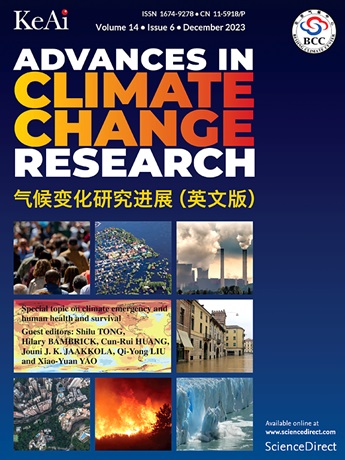Assessing the impact of artificial geotextile covers on glacier mass balance and energy fluxes
IF 6.4
1区 地球科学
Q1 ENVIRONMENTAL SCIENCES
引用次数: 0
Abstract
As global warming accelerates, leading to the retreat of glaciers, the effectiveness of artificial coverings, in particular geotextiles, in reducing glacier ablation has emerged as a topic of increasing concern. Nevertheless, a critical gap in knowledge persists regarding the specific physical processes involved in the mitigation provided by these coverings. This study explores the underlying mechanisms that govern the interaction through field observations and COSIPY model simulations at Bailanghe Glacier No. 21 in the Qilian Mountains from 26 June to September 17, 2023. It compares covered and uncovered areas to evaluate differences in mass and energy balance fluxes. It was discovered that geotextiles could decrease ice melt by up to 1000 mm w.e. in comparison to the surface of glaciers without cover, primarily because of a 23% increase in albedo compared to ice, leading to a decrease in net short-wave radiation and available melt energy. The effect of covering the entire glacier with a geotextile, which has varying albedo properties, was also simulated. It was found that, with every 5% increase in the albedo of the geotextile, ablation was reduced by 10%–25%, resulting in a decrease in ice volume loss of approximately 2.5 × 105 m3. While artificially covering glaciers can reduce ablation rates, it faces challenges such as high costs, environmental risks, and issues with replicability. Ultimately, this study aims to analyze the feasibility of glacier coverage from a mechanistic perspective for glacier management amidst ongoing climate change.
评估人工土工布覆盖对冰川物质平衡和能量通量的影响
随着全球变暖的加速,导致冰川的退缩,人工覆盖物,特别是土工布,在减少冰川消融方面的有效性已经成为一个越来越受关注的话题。然而,对于这些覆盖物所提供的减缓作用所涉及的具体物理过程,仍然存在严重的知识空白。通过2023年6月26日至9月17日在祁连山白浪河21号冰川的野外观测和COSIPY模式模拟,探讨了二者相互作用的潜在机制。它比较覆盖和未覆盖的区域,以评估质量和能量平衡通量的差异。研究发现,与没有覆盖的冰川表面相比,土工布可以使冰融化减少1000毫米w.e.,这主要是因为与冰相比,反照率增加了23%,导致净短波辐射和可用融化能减少。用具有不同反照率特性的土工布覆盖整个冰川的效果也进行了模拟。研究发现,土工布的反照率每增加5%,消融就会减少10%-25%,导致冰体积损失减少约2.5 × 105 m3。虽然人工覆盖冰川可以降低消融速度,但它面临着诸如高成本、环境风险和可复制性问题等挑战。最后,本研究旨在从机制角度分析冰川覆盖在持续气候变化中冰川管理的可行性。
本文章由计算机程序翻译,如有差异,请以英文原文为准。
求助全文
约1分钟内获得全文
求助全文
来源期刊

Advances in Climate Change Research
Earth and Planetary Sciences-Atmospheric Science
CiteScore
9.80
自引率
4.10%
发文量
424
审稿时长
107 days
期刊介绍:
Advances in Climate Change Research publishes scientific research and analyses on climate change and the interactions of climate change with society. This journal encompasses basic science and economic, social, and policy research, including studies on mitigation and adaptation to climate change.
Advances in Climate Change Research attempts to promote research in climate change and provide an impetus for the application of research achievements in numerous aspects, such as socioeconomic sustainable development, responses to the adaptation and mitigation of climate change, diplomatic negotiations of climate and environment policies, and the protection and exploitation of natural resources.
 求助内容:
求助内容: 应助结果提醒方式:
应助结果提醒方式:


